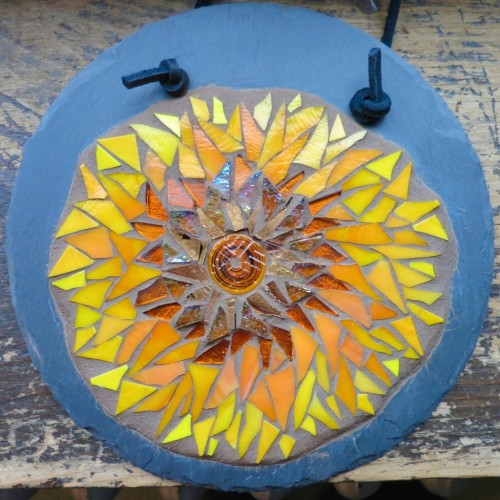
This was to be a yellow sunflower, but the orange slipped in. Yellow is pliable and molds into orange easily. The days are going to get longer now that the Winter Solstice is here. The sun will slip into the darkness and intertwine night into day.

This was to be a yellow sunflower, but the orange slipped in. Yellow is pliable and molds into orange easily. The days are going to get longer now that the Winter Solstice is here. The sun will slip into the darkness and intertwine night into day.
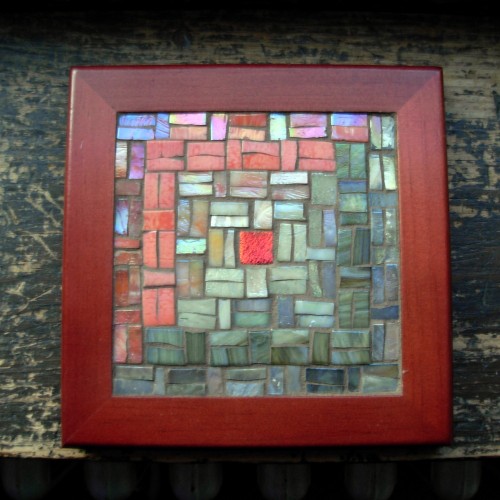
Stratoz created a festive 21 Days of Free Shipping on 21 of our creations. Fortunately, some of them are orange, including one of my quilt inspired trivets, a jazz inspired suncatcher and a blue spiral through the orange desert in mandala form. Click on any of these photos to go to the listing and order. December 15th is the last day to participate in the free shipping.
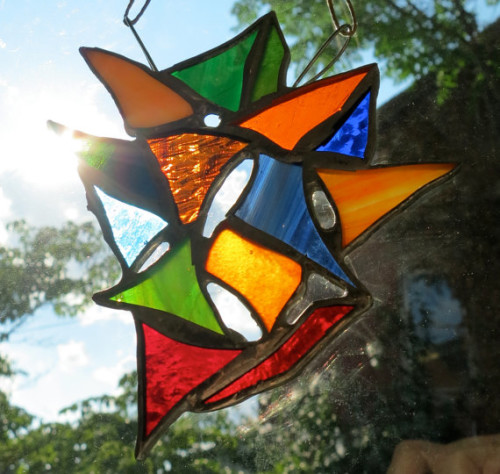
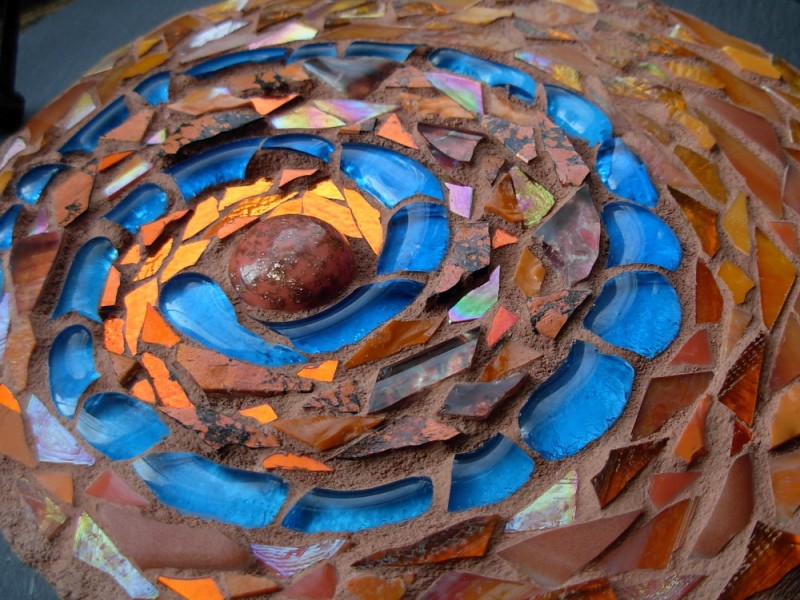
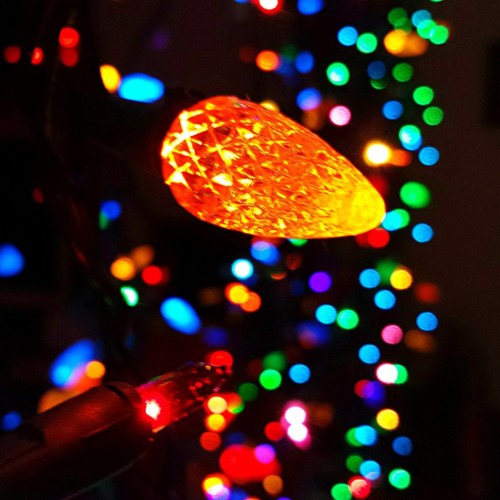
My Partner-in-Craft is taking good care of me as the days get shorter. He set up the Wall of Lights, after much untangling. The tradition started a few years back when we were too exhausted from doing craft shows every weekend to set up a Christmas tree, and instead Stratoz hung all the lights in between the living and dining room. It was an infusion of color and light in the darkness and we leave it up until March.
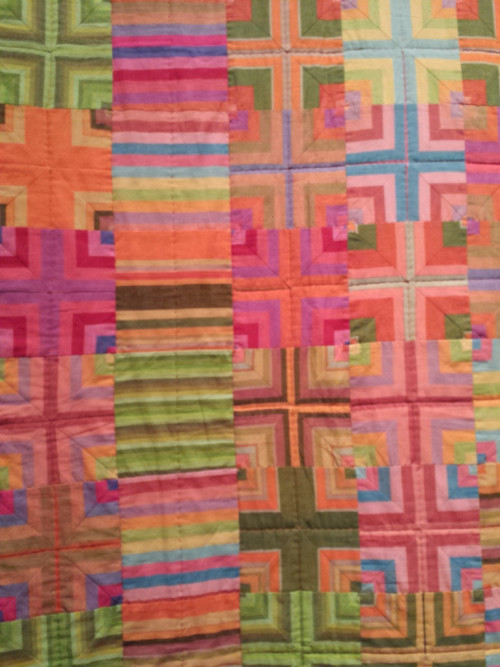
I went on an excursion in the rain to the Michener Art Museum in Doylestown to hear a talk by Kaffe Fassett about color. The first book I owned about mosaic was by Kaffe Fassett, and I was drawn to his use of color. Fassett has created art in many mediums from knitting, fabric design, quilting and mosaic. Someone in the audience asked him if he had a favorite medium, and he said no, that it was all a vehicle for playing with color, that he calls his studio a color laboratory. He sees color choices as an intuitive process, trying out different combinations of fabric on flannel “audition” boards until the colors vibrate or click. Fasset’s first medium was painting and painted only in shades of white! Another audience member asked if this was his preparation for moving to color, and he said yes, it was a kind of palate cleanser.
My first medium was collage, and color was my love. A friend asked if I had thought of being a painter because of my use of color, and it hadn’t occurred to me. I just wanted all the color. Looking at my photo from my previous blog post, Verve Patchwork in Orange, I recognize both a kinship with quilts and with collage, particularly the wood collage from another exhibit at the Michener, Pattern Pieces.
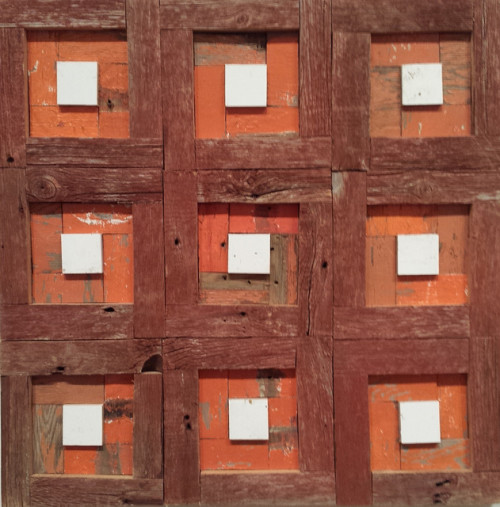
Look at this quilt-like patchwork of orange by New Jersey artist Laura Petrovich-Chaney. She created a series of sculptures using wood salvaged from homes after Superstorm Sandy. Watch this moving interview with Petrovich-Chaney on the Weather Channel about her project.
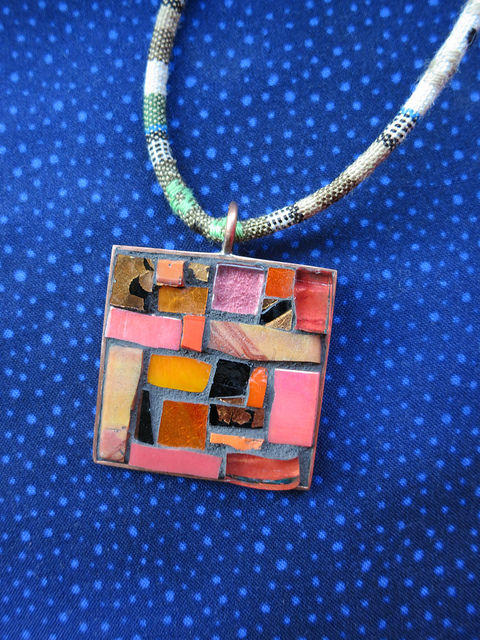
For a winter infusion of color and joy, be sure to get to these exhibits. The Fassett quilts are inspired by historical quilts and are laid side by side to see the new interpretation of amazing quilts from the past. I had to detour myself around the gift shop, since there were many tempting books by Fassett as well as ribbon from collection with Brandon Mably and Kaffe Fassett Studio. I was knitting while waiting for the lecture to start and the woman next to me said she wished they were selling yarn as well. I would’ve bought yarn.
Brandon Mably introduced Kaffe at the beginning of the lecture and told us how he helped yarn store owners learn to pronounce his name, “You have a safe assett with Kaffe Fassett.”
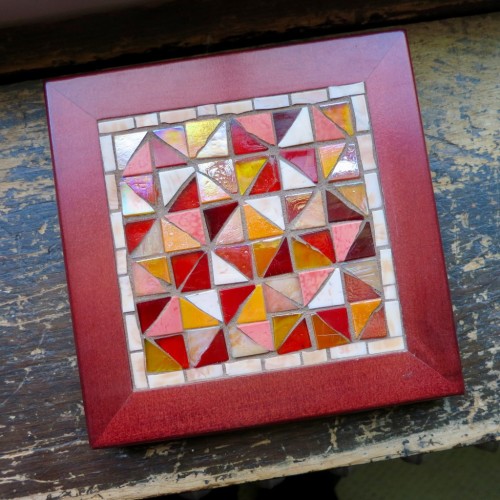
No dishes were harmed in the making of this quilt block trivet. Broken Dishes is one of my favorite quilt patterns, and I enjoy the fact that I use only glass tile in creating the design in mosaic. There is a form of mosaic, Pique Assiette, that is made entirely from broken dishes. Glass is my love. The creative spirit incarnates in many different forms and mediums, and for a long time I thought I loved sewing, when in fact what I loved was fabric and pattern.
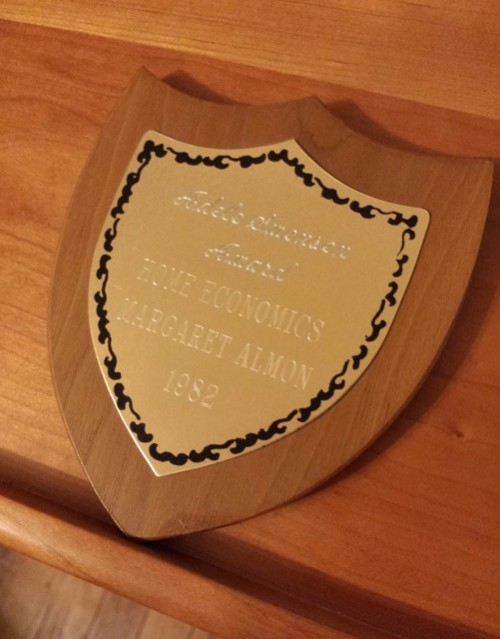
I keep this award for junior high Home Economics in my studio as a reminder of two things: 1)Just because you are good at something doesn’t mean you have to do it and 2)Creative energies get shepherded into available enclosures. For awhile, somewhere between grade 8 and grade 9, I thought I wanted to be a Home Ec teacher. I’ve wondered who Adele Swensen was. When I looked her up a blog post I’d written in 2007, on a long-forgotten blog, appeared. I thought I would share some of it here:
I was the girl who had a talent for reading pattern instructions. I would read anything. Reading was my drug for the pain of junior high, and this compulsion came in handy in Home Ec. Most of the other girls didn’t read the instruction sheet, or didn’t understand it, and would ask the teacher what to do next. This puzzled me; asking a question was not something I ever considered. This is the irony that I became a Reference Librarian, without ever having asked a Librarian a question. I expected myself to know before knowing, to know everything in advance.
In Home Ec, the feeling of power that came from comprehending the instructions and answering other girls’ questions inspired me to tell my parents I wanted to become a Home Economics teacher. This was definitely “not to my potential.” Yes, one could major in Home Ec at the University, but there was an unspoken belief that cooking and sewing were not truly academic subjects, but women’s work.
The confounding factor was that sewing made me cry. All manner of emotional pain could not bring the tears, but a crooked seam, or a ratty looking bobbin thread could bring me to sobs. I loved the big pattern books on the tilted tables. I loved fabric, the texture and colors. I loved that weaves had names like herringbone, and that they were identifiable. I loved notions like zippers and buttons and thread. I loved the smell of sewing machine oil and the line drawings on newsprint illustrating each step of construction. But actual sewing tested my limits: I wanted it exactly right. I saw flaws that no one else did, which made me well acquainted with my seam ripper(which in spite of its association with imperfection, was still a lovely notion).
I felt I should want to to sew, that the Adele Swensen award meant something about my destiny. As an adult, I went through a time of wanting to make quilts, circling back to the sewing machine that tormented me. I finally had the revelation that I did not like sewing. I loved quilts, but to actually make one, no. Instead my husband decided he wanted to continue his grandmother’s legacy and learn to quilt and I gave him my sewing machine. His keen spatial abilities allowed him to align seams with precision.
That year I made Christmas cards in a log cabin quilt design with magazine papers in red and green, and it was a delight. And then when I started making mosaics, I made quilt designs in glass, and this was even more delightful! This is what happens when you discover your medium. Not that I don’t ever get frustrated, but the joy outweighs it. The impulse to make something beautiful can be incarnated in many forms. *Women’s work* has what beauty has arisen from it, needlework, sewing, quilting. A quilt is often the only legacy from women in our family histories,their biography in cloth, and I hope to write mine in glass.

On the latest 2015 pilgrimage to the Corning Museum of Glass, this piece by Judy Tuwaletstiwa was new. I read the tag with interest:
Judy Tuwaletstiwa began her career as a weaver and a painter and first worked with glass in 1998. In her painting ruah. to spit, small fused-glass elements were used like brushstrokes. To create them, she mixed her own specially colored glass powders and spooned them onto the shelves of a kiln, fusing them into long, oval shapes that she glued onto a painted canvas. The granular texture of the glass elements gives her painting a three-dimensional quality.
The way Tuwaletstiwa moves among mediums, from weaving to painting, to clay to glass and yet her vision unifies them, and finds the commonalities. Textiles, especially quilts, are what excite my own glass art, and when I look at this piece, I see the influence of fabric, and yet, not a rote copying of another medium, but being informed by it.
In an article on the National Geographic site, she describes thinking like an artist:
Learn to see. Really see. Notice the smallest blade ofgrass. How the light reflects off of it, how it grows. Notice what is around you. Turn off the television. Sit in silence. Listen. Each day notice something new. Educate yourself. Do not let a day pass by without noticing something you didn’t see the day before. When you look at a photograph, study it. Learn about this large world in which we live.
Also check out her exercise in thinking with your hands by modeling clay:
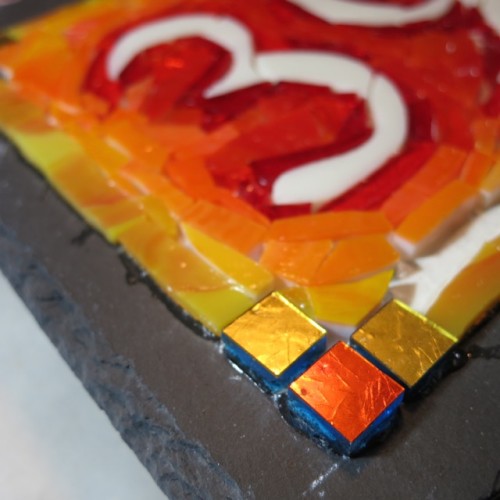
Kindred Spirits in orange-love requested an ombre background to their 3901 house number. Stratoz was telling me about studies of how the brain edits the world for us, filling in the gaps, making senses synchronous. Seeing is an action. I have gotten better at imagining how a mosaic will look once grouted, how the colors will flow. When I first started grouting the uncertainty was intense. What will happen once I slather the glass with grout? Will the design emerge or will it be fragmented? Ombre reminds me of Impressionist painting, where the artists let the eye blend the dots and strokes of color.

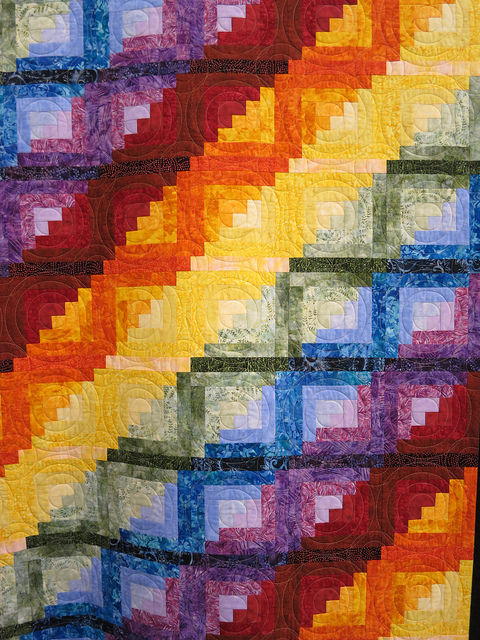
Another pleasure at the Keystone Quilters 2015 Show was coming across a Rainbow Log Cabin made by Dorothy Fravel. For my kindred spirits in Log Cabin Love, I just finished a Rainbow version of my own the week before, and look forward to sharing it with you.
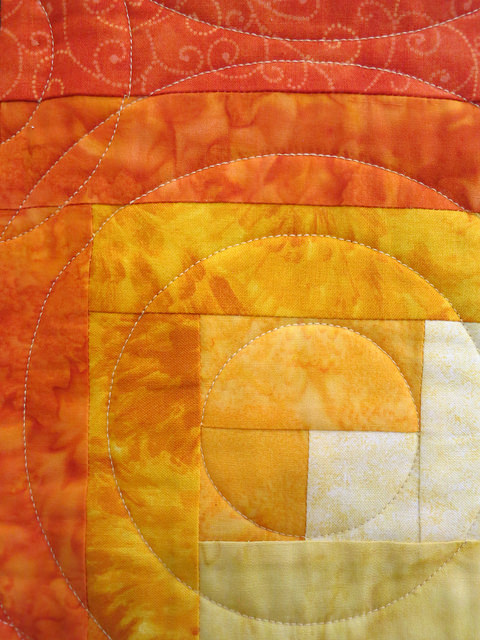
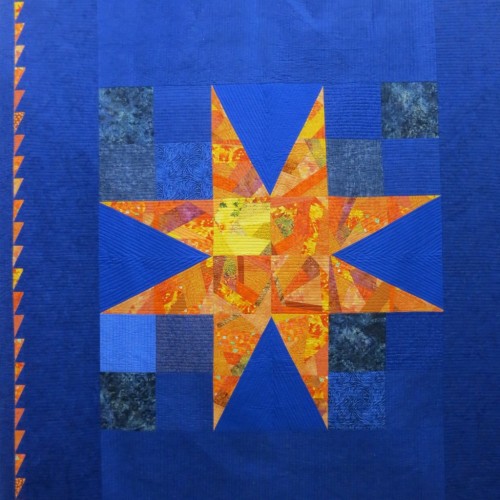
Driving to the Keystone Quilters Guild 2015 Quilt Show, Stratoz and I got a bit turned around, but the leaves were gorgeous and snuck in when we weren’t looking. This Bright Star quilt by Jamee Pemberton caught my eye, with its autumn orange, those little sawteeth along the border. She made it for her nephew Shaun.
Here is a beautiful piece by pianist Catherine Marie Charlton called Stars Awaken from her Riversong album. I imagine an awakening star to look something like Jamee Pemberton’s Bright Star.